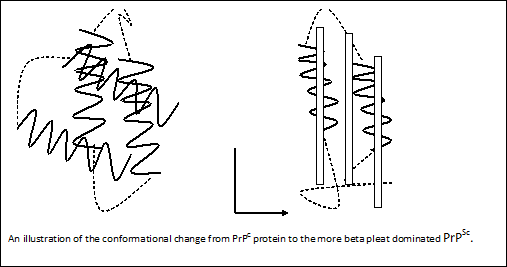Prions

The word prion is an acronym for proteinaceous infectious particle only. Prions are relatively new in the world of science, and are currently being very highly researched. They are made just of proteins, but are altered. PrPC is a membrane protein expressed in most tissues, but more prominently so in brain and neural tissue, and it is encoded from the PrP gene. PrPC must be present in order for an organism to develop a prion disease. Ordinary membrane proteins are referred to as PrPC, and the isoform that infects these proteins is called PrPSc.
PrPSc proteins infect normal PrPC proteins and alter their composition. PrPC is made up mostly of alpha helix structures, and has almost no beta pleats. However, PrPSc proteins are composed of approximately 43% beta sheets, and when these pleats congregate they are able to form complex fibrous structures. These fibrous structures allow for the newly altered proteins to bind together. The PrPSc proteins are folded atypically due to the increase in beta pleats, and can also be distinguished by their resistance to proteases.

The interactions of prions with themselves are very different from most other organisms. Their unique ability to alter the conformation of other proteins without genetic material, is amazing. Prion interaction with animals is also unique in that is causes degeneration of neural tissue through an infection.